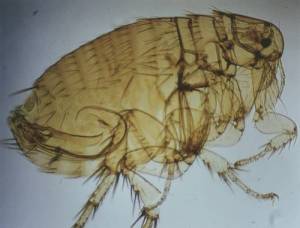
Fleas
A page about flea infection in dogs describing cause, clinical signs, diagnosis and control.
Introduction

Fleas are small, 6 legged, blood-sucking parasitic insects that feed on warm-blooded animals. All fleas are wingless, so their main mode of travel is jumping. They can jump more than 100 times their own length facilitated by their relatively long hind legs! Furthermore thay are flattened from side-to-side and have hairs and spines, which makes it easy for them to travel through hair.
Aetiology

The flea’s mouthparts are adapted for piercing skin and sucking blood. Under a microscope the mouthparts among other parts of the flea anatomy are used to determine the species of flea. For example, the dog flea can be distinguished from the cat flea by its head, which is rounded towards the front rather than elongated. Furthermore, the tibiae of its hind legs have eight setae-bearing notches rather than six.
Photo courtesy of Prof. Dr. H. Mehlhorn, Heinrich Heine University Düsseldorf & Intervet International bv
Epidemiology

The flea life cycle begins with flea eggs which are oval 0.5 mm in length, off-white in colour and are barely visible to the naked eye. Eggs usually hatch in 1-10 days depending on correct conditions of humidity and temperature and larvae are produced. These feed on environmental organic debris and faeces of adult fleas. The larvae avoid direct sunlight and move deep in household fabrics or indeed outdoors low down in grass, leaves or soil. This stage of the life cycle usually lasts from 5-10 days but can be prolonged to many weeks depending again on environmental conditions. As moisture is critical for larval survival, they may only survive for these longer periods in households in protected locations such as deep in carpets or in cracks between floor boards.
When larvae have fully developed they pupate (produce a cocoon of silk in which they become enshrouded). Under optimal environmental conditions, (high temperature and humidity), adult fleas emerge after approximately 8-10 days. An interesting aspect of the life cycle is that the adult fleas may not emerge for months unless they are stimulated by physical pressure, carbon dioxide, and/or heat. This stage can increase the total length of the life cycle significantly due to this variability. The life cycle therefore can be as short as 12-14 days or as long as many months. In most home environments, fleas commonly have a life cycle of 3 to 8 weeks.
Newly emerged adult fleas are attracted to potential host pets by various stimuli produced by these hosts including body heat, exhaled carbon dioxide and interestingly movement. Finally, these newly emerged flea can survive several days to a few weeks, which again alters the length of the life cycle. This variation again depends on temperature and humidity.
The adult however has a fundamental requirement for a blood meal from the host on which they land. After feeding, the adult will start feeding within 5 minutes and may suck blood for up to 2½ hours. Female fleas are the most voracious, consuming up to 15 times their own body weight in blood. Mating occurs in the first 8-24 hours and egg production starts from 24 hours after the first blood meal. A single flea can live on your dog or cat for almost 2 months! Females lay eggs at a rate of 40 to 50 per day for around 50 days with a single female producing up to 2,000 eggs!
Clinical Signs

Clinical signs of flea infestation can result in direct or indirect signs. Direct signs are attributable directly to the presence of the flea while indirect result from agents carried by fleas – the so called Flea borne diseases.
DIRECT
When fleas bite, they can cause a range of signs including:
- Mild skin irritation
- Intense itching and biting of skin
- Hair loss
- Skin infections (‘ hot spots’) – These arise due to the blood sucking behaviour of the flea “injecting in” skin surface bacteria into the animal resulting in a localised skin infection evident in the area around the bite.
- Some dogs develop an allergy to the saliva of the flea, this is known as flea allergy dermatitis (FAD). When animals are initially exposed, the immune system develops a hypersensitive response. Once the immune system of these animals is subsequently exposed to more fleas biting, an allergic reaction is triggered. This results in intense itching that lingers long after the flea bite. FAD is commonly associated with hair loss (especially over the rump as in photo) and secondary bacterial infections.
- Very heavy infestations in young animals can result in excessive blood loss resulting in anaemia and occasionally death.
It is important to note that many dogs that harbour fleas may not display any signs at all!
Indirect

Fleas can also transmit bacterial diseases to both animals and humans. Human fleas for example can transmit serious diseases in humans such as Bubonic plague. In Ireland and the UK, dog (and cat) fleas can transmit the tapeworm Dipylidium caninum – known commonly as the dog tapeworm or sometimes even the flea tapeworm (see photo). This happens when flea larvae feed on the eggs of this tapeworm. Once swallowed, the tapeworms begin to develop in the gut of the flea into immature forms called cysticercoids. When grooming themselves, dogs and cats may ingest fleas that contain the tapeworm cysticercoids. Inside the digestive tract of dogs and cats the cysticercoids are released and develop into adult tapeworms in the intestine. The same thing can happen in people, for example, if a child happens to swallow an infected flea. Clinical signs associated with this tapeworm include abdominal discomfort, bloating, diarrhea and constipation. Tapeworm infestations can be effectively treated using appropriate anthelmintic products.
Diagnosis

The characteristic signs of scratching etc. listed under Clinical Signs lead to a presumptive diagnosis. Adult fleas can sometimes be easy to spot, particularly in short and light-colored fur. They are more difficult to find in dark-haired pets. Also, pets may groom the fleas out before you have a chance to see them, so your pet may have fleas, but you may not always see them. Try parting the coat near the base of the tail using your hands or a flea comb and look for movement. Most fleas grow to about the size of a pinhead and will move or jump when disturbed.
Even if you don’t see any fleas, have a look for dark, pepper-like particles on the surface of your pet’s skin and coat. These may be ‘flea dirt’, which are flea droppings. You can easily confirm this by dabbing some of this material with a wet paper towel or cotton ball. If you see dark reddish brown or orange swirls, this is flea dirt and confirms that your pet has fleas.
The flea’s mouthparts are adapted for piercing skin and sucking blood. Under a microscope the mouthparts among other parts of the flea anatomy are used to determine the species of flea. For example, the dog flea can be distinguished from the cat flea by its head, which is rounded towards the front rather than elongated. Furthermore, the tibiae of its hind legs have eight setae-bearing notches rather than six.
Flea allergic dermatitis is characterised by hair loss, often located over the rump (photo) and resolves quite well when long-term flea control is instituted. Hot spots also no longer develop if the underlying infestation is controlled.

Control
Two aspects of control exist –

a) Treating an existing infestation
A variety of formulations containing various active ingredients exist for treating flea infestation. Some products also repel or kill ticks. Presentations include collars, spot-ons, shampoos, dips, injections, powders, sprays and oral medications. Some products contain insecticidal products that kill adult fleas while others contain insect growth regulators that target developing stages. The duration of protection is generally very short with shampoos, dips, powders and sprays while collars tend to provide more prolonged protection. To achieve the goal of treating existing infestation, you need to use a product that it fast acting as this will result in early resolution of clinical signs. Consult your vet for details.
B) Preventing future infestations
To stop repeat infestations, you need to break the flea life cycle once and for all. Veterinary practitioners recommend using flea products on all pets in the house all year-round to maximise likehihood of this break. Using a long acting product is best for achieving prevention of future infestations as it minimises the likelihood of forgetting to treat the animals concerned i.e owner compliance is improved.
To reduce the number of flea eggs, larvae and pupae in your home:
• Wash all your pet’s bedding at a high temperature.
• Vacuum your carpets and furniture to remove eggs, larvae and pupae and discard the vacuum cleaner bag. By targeting all the hideouts at once, you help break the life cycle and keep your pet and your house flea-free.
MSD Animal Health has introduced an oral medication for fleas and ticks to the Irish market which is both fast acting and long acting. This product can be used for treating an existing infestation and preventing future infestations. Consult your vet for details. Further information may be obtained on this product by clicking here. You may also view a brief introductory video on this novel approach to flea and tick control by clicking here.
*Immediate and persistent tick killing activity for 12 weeks for Ixodes ricinus, Dermacentor reticulatus and D. variabilis and for 8 weeks for Rhipicephalus sanguineus
